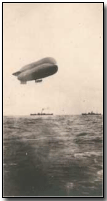Encyclopedia - Coastal Class Airships
 Coastal Class Airships were
developed by the British Royal Naval Air Service (RNAS) as a means of
guarding the British coast against German attack, typically via submarines
and
Zeppelins.
Coastal Class Airships were
developed by the British Royal Naval Air Service (RNAS) as a means of
guarding the British coast against German attack, typically via submarines
and
Zeppelins.
Coastal Class Airships, which were non-rigid and an extension of Sea Scout design, were designed to stay airborne for longer periods - up to 22 hours - and to carry ever-larger bomb loads. They were often used to protect convoys.
To minimise costs as far as was feasible existing technology and equipment was utilised; this had the dual benefit of not only being cheaper but also ensured that production capacity was higher from the outset. The airship's gondola was designed around two shortened aircraft fuselages jointly connected, powered by two 150 horse-power Sunbeam engines (later replaced by 220 horse-power Renaults).
In terms of munitions the airships carried a bomb load and two machine guns; the airships also carried a wireless set.
There were two types of Coastal Class Airship; a standard Coastal and a 'C' (C Star) Class, e.g. the C9. The airships were 195 feet in length, 37 feet in diameter and 52 feet in height. Their top speed was approximately 80 kph.
The aircraft's envelope capacity was some 170,000 cubic feet and the airship could carry up to 220 gallons of fuel. It could gain height at up to 1,000 feet per minute up to a maximum height of 8,000 feet.
45 airships of this type were produced during the war; of these just two were destroyed by enemy fire. Others were sold to the Russian government.
"Devil Dogs" was the nickname given to the U.S. Marines by the German Army.
- Did you know?
